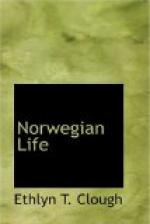Norway is not rich in mineral products. The combined mining industries do not yield more than two million dollars a year, and they furnish employment to less than four thousand men. The Kongsberg silver mines have been operated for more than three hundred years, but the recent fall in the price of silver has reduced the output. The copper mines at Roroes have been operated for two hundred and fifty years, and there are less important copper mines in Nordland, Telemarken, and the Hardanger. There are iron mines at Arendal and elsewhere, but the rise in the cost of charcoal, due to the scarcity of wood, has greatly crippled the iron industry. There are important soapstone quarries in the Gudbransdal and the Trondhjem basin; green colored slate in the Valders and at Vossevangen; and granite, syenite, and porphyry in many parts of the country.
Measured by population and national wealth, the commerce of Norway is relatively important, due in a large measure to her enormous merchant marine and the efficiency of her hardy seamen. Relatively to the population of the country, Norway has the largest merchant fleet in the world, and in the matter of steamships and sailing vessels she is surpassed only by three countries—Great Britain, Germany, and the United States. Not only is her fleet large, but her service is efficient. Norwegian seamen the world over are esteemed for ability and honesty, inspiring all commercial nations with confidence that goods carried in Norse bottoms will be carefully and conscientiously treated; and her seamen are everywhere sought to man foreign vessels.
In industries, the Swedes excel in the manufacture of iron. To fully appreciate the value of this industry, one should visit Gefle, the most important shipping point on the eastern coast of Sweden. Here there is a fine harbor, with docks and warehouses owned by the government. From this port the ore from the mines of central Sweden is shipped to all parts of the world and handled by Brown hoisting machinery, which is made in Cleveland, Ohio—the same that you see on the ore docks at South Chicago and at Cleveland, Buffalo, Ashtabula, and other points on the Great Lakes where iron ore and coal are handled.
At Gefle, too, an annual industrial exposition is held, where you may see on exhibit all the utensils manufactured or used by the people—all kinds of machinery, tools, and implements, recent novelties in patents, weaving, wood-carving, and a large part of the exposition building is given up to beautiful articles in iron, in the manufacture of which we have said the Swedes excel.




